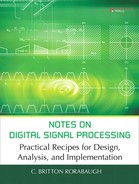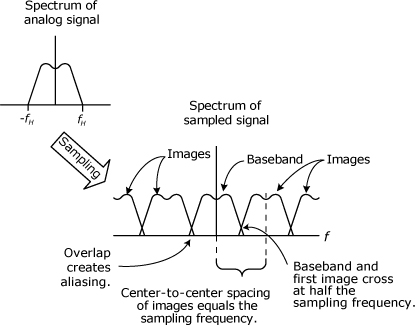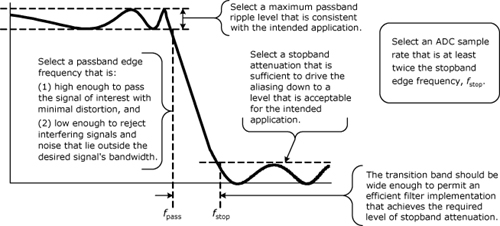Note 4. Practical Application of Ideal Sampling
This note shows how theoretical results from Note 3 are used to develop a practical sampling strategy that minimizes the effects of aliasing.
In the discussions of aliasing in Note 3, the frequency fH is portrayed as an absolute upper frequency. Prior to sampling, the signal of interest has zero spectral content at frequencies greater than fH. Under these conditions, sampling at rates greater than 2fH would result in no aliasing. However, this ideal situation is impossible to achieve in practical applications, where there will always be some aliasing. In many cases, even to achieve extremely low levels of aliasing, fH would have to be set so high that, in most cases, sampling at a rate of 2fH would be prohibitively difficult and expensive. In practical situations, rather than trying to avoid all aliasing, the design goal is to minimize the effects of aliasing while recognizing that they can not be completely eliminated.
Practical sampling is performed at a rate greater than 2fH, where the signal of interest is known to have negligible (rather than zero) spectral content above some upper frequency, fH. The definition of “negligible” varies based on the particular application. In some cases, fH might be set so restrictively that less than 0.01 percent of the signal’s energy is at frequencies greater than fH. In less demanding applications in which the analog-to-digital converter (ADC) cost may need to be kept low, fH may be set lower to allow up to 5 percent of the signal’s energy to be at frequencies greater than fH.
In most applications, the signal is passed through an anti-aliasing filter prior to being digitized. The purpose of that filter is to ensure that aliasing is held to tolerably low levels. A value for fH can be chosen based on the properties of the signal of interest and the requirements of the application, but in real-world situations, it is generally not possible to guarantee that the chosen value for fH bounds the frequency extent of the actual signal that is presented to the ADC. There are several reasons why this is so:
• The signal of interest may be contaminated with wideband additive noise.
• The signal of interest may be contaminated with an unanticipated interfering signal having a bandwidth that extends beyond fH.
• The signal of interest may contain spurious self-interference caused by nonlinear processing in a mixer or a saturated amplifier prior to sampling. Because nonlinear processing creates components at new frequencies, some of this self-interference may occur at frequencies above fH.
The selection of the sampling rate, fs, and the design of the anti-aliasing filter are coordinated, observing the guidelines called out in Design Strategy 4.1, so that the filter produces minimal attenuation or distortion for frequencies below fH, but provides severe attenuation for all frequencies above fs/2.
References
1. A.V. Oppenheim and R.W. Schafer, Discrete-Time Signal Processing, Prentice Hall, 1989.
2. R.A. Roberts and C.T. Mullis, Digital Signal Processing, Addison-Wesley, 1987.


